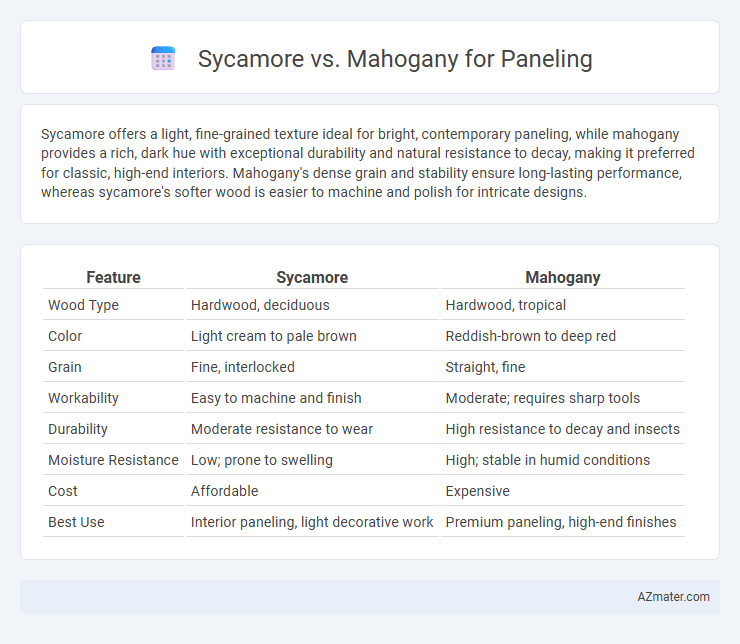Sycamore offers a light, fine-grained texture ideal for bright, contemporary paneling, while mahogany provides a rich, dark hue with exceptional durability and natural resistance to decay, making it preferred for classic, high-end interiors. Mahogany's dense grain and stability ensure long-lasting performance, whereas sycamore's softer wood is easier to machine and polish for intricate designs.
Table of Comparison
| Feature | Sycamore | Mahogany |
|---|---|---|
| Wood Type | Hardwood, deciduous | Hardwood, tropical |
| Color | Light cream to pale brown | Reddish-brown to deep red |
| Grain | Fine, interlocked | Straight, fine |
| Workability | Easy to machine and finish | Moderate; requires sharp tools |
| Durability | Moderate resistance to wear | High resistance to decay and insects |
| Moisture Resistance | Low; prone to swelling | High; stable in humid conditions |
| Cost | Affordable | Expensive |
| Best Use | Interior paneling, light decorative work | Premium paneling, high-end finishes |
Introduction to Sycamore and Mahogany Paneling
Sycamore paneling showcases a light, creamy hue with a fine, consistent grain pattern ideal for brightening interior spaces and creating a warm, inviting atmosphere. Mahogany paneling offers a rich, deep reddish-brown color coupled with exceptional durability and resistance to moisture, making it a preferred choice for luxurious, long-lasting woodwork. Both woods provide distinct aesthetic and functional benefits, influencing decisions based on design preferences and environmental conditions.
Botanical Origins and Wood Characteristics
Sycamore, botanically known as Platanus occidentalis, features pale, fine-grained wood with a subtle, wavy figure, making it ideal for light, smooth paneling applications. Mahogany primarily refers to species within the genus Swietenia, recognized for its deep reddish-brown color, straight grain, and high durability, offering a rich, classic look for interior paneling. The dense fiber structure of mahogany enhances its resistance to wear and warping compared to the softer, more porous sycamore wood.
Visual Appeal: Grain Patterns and Color
Sycamore paneling features subtle, wavy grain patterns with a light, creamy color that creates a bright and airy interior atmosphere. Mahogany offers a rich, deep reddish-brown hue with a straight, fine grain that exudes warmth and elegance. Choosing between sycamore and mahogany depends on whether a space calls for light, natural brightness or a classic, sophisticated appearance.
Durability and Hardness Comparison
Sycamore paneling offers moderate durability with a Janka hardness rating of approximately 1,300, making it suitable for interior applications that experience light to medium wear. Mahogany, known for its exceptional durability and a Janka hardness around 1,200 to 1,500 depending on the species, provides a robust surface resistant to dents and scratches, ideal for high-traffic areas. Both woods deliver good hardness, but mahogany's consistent density and resistance to decay give it a slight edge in long-term durability for paneling projects.
Workability and Ease of Installation
Sycamore offers excellent workability, featuring a fine, uniform texture that allows for smooth cutting, sanding, and shaping, making it ideal for intricate paneling designs. Mahogany, while slightly harder, provides good machinability with natural resistance to warping and splitting, ensuring durable and straightforward installation. Both woods deliver ease of installation, but sycamore's lighter weight and consistent grain often make it a preferred choice for detailed and efficient paneling projects.
Finishing Options: Staining and Polishing
Sycamore offers a light, fine-grained surface that readily accepts stains, allowing for a wide range of color customization from pale whites to rich ambers, while its smooth texture ensures an even polish with a subtle sheen. Mahogany features a denser, coarse grain that responds well to darker stains, enhancing its natural reddish-brown hues and providing a deep, luxurious finish that highlights the wood's rich character. Both woods can be polished to achieve a glossy or satin finish, but mahogany's natural oils aid in producing a higher luster and more durable surface compared to sycamore.
Maintenance and Longevity
Sycamore paneling requires less maintenance due to its resistance to warping and insect damage, making it ideal for humid environments. Mahogany offers superior longevity with its dense, oily grain that naturally repels moisture and pests, extending the lifespan of wall panels up to several decades. Regular sealing and occasional polishing enhance the durability of both woods, but mahogany's inherent durability often results in lower long-term upkeep costs.
Environmental Impact and Sustainability
Sycamore paneling is often considered more sustainable due to its faster growth rate and wider availability compared to mahogany, which is a slow-growing hardwood frequently harvested from tropical rainforests, raising concerns over deforestation and habitat loss. Mahogany's environmental impact is higher because illegal logging and overharvesting threaten its natural populations, whereas sycamore is primarily sourced from well-managed temperate forests with lower ecological footprints. Choosing sycamore supports reduced carbon emissions and promotes responsible forestry practices, making it the greener option for eco-conscious interior wood paneling.
Cost Analysis: Sycamore vs Mahogany
Sycamore paneling typically costs significantly less than mahogany, offering an economical option for high-quality wood finishes. Mahogany's premium price reflects its durability, rich color, and resistance to moisture, making it a long-term investment despite the higher upfront cost. Budget-conscious projects often favor sycamore due to its affordability while maintaining an attractive grain and finish.
Best Applications for Each Wood Type
Sycamore paneling excels in brightening interiors and is ideal for rooms requiring a light, airy aesthetic due to its pale color and fine grain. Mahogany is best suited for formal spaces or areas needing rich, warm tones, offering durability and a luxurious deep reddish-brown appearance. Choosing sycamore enhances casual or contemporary designs, while mahogany complements traditional or high-end architectural settings.

Infographic: Sycamore vs Mahogany for Paneling
 azmater.com
azmater.com